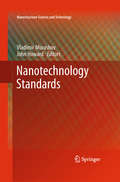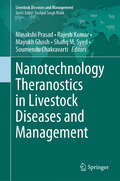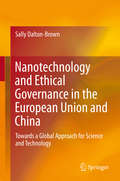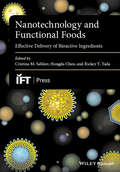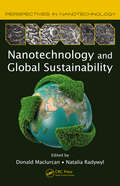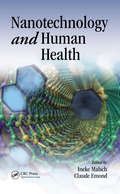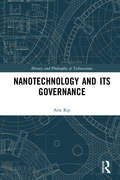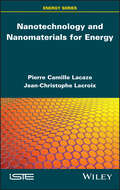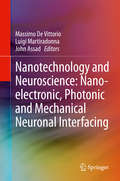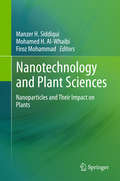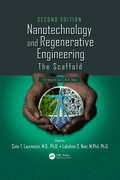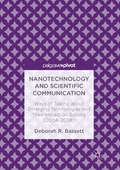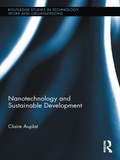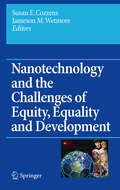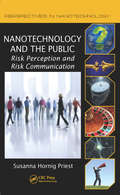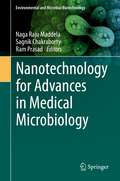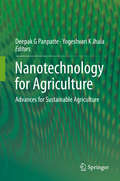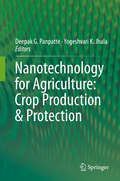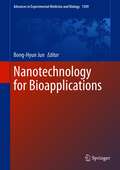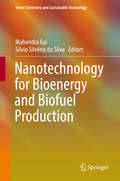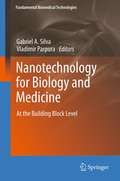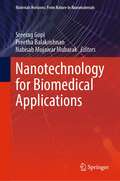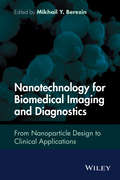- Table View
- List View
Nanotechnology Standards
by John Howard Vladimir MurashovWritten by a team of experts, Nanotechnology Standards provides the first comprehensive, state-of-the-art reviews of nanotechnology standards development, both in the field of standards development and in specific areas of nanotechnology. It also describes global standards-developing processes for nanotechnology, which can be extended to other emerging technologies. For topics related to nanotechnology, the reviews summarize active areas of standards development, supporting knowledge and future directions in easy-to-understand language aimed at a broad technical audience. This unique book is also an excellent resource for up-to-date information on the growing base of knowledge supporting the introduction of nanotechnology standards and applications into the market.
Nanotechnology Theranostics in Livestock Diseases and Management (Livestock Diseases and Management)
by Rajesh Kumar Minakshi Prasad Mayukh Ghosh Shafiq M. Syed Soumendu ChakravartiThis book reviews various applications of nanotechnology in the prophylactic, diagnostic, and therapeutic management of livestock diseases. The initial section discusses the strategies for the synthesis of nanomaterials and characterization of different nanomaterials. The subsequent chapters explore the role of nanoparticles in the diagnosis of diseases caused by pathogenic microorganisms, including bacteria, viruses, protozoans, and fungi. The book also examines the nano sensors that are used for point-of-care diagnosis of various livestock diseases. Additionally, it highlights nanoparticles-based vaccines and vaccine delivery systems to combat bacterial livestock diseases. Lastly, the book entails the strategies for developing nanotherapeutics for the treatment of bacterial, viral, fungal diseases, metabolic disorders, and cancer in livestock animals. The content of this book is useful for researchers and practitioners interested in understanding the applications of nanotechnology in diagnostics and therapeutics of livestock diseases.
Nanotechnology and Ethical Governance in the European Union and China
by Sally Dalton-BrownThis book addresses questions surrounding the feasibility of a global approach to ethical governance of science and technology. The emergence and rapid spread of nanotechnology offers a test case for how the world might act when confronted with a technology that could transform the global economy and provide solutions to issues such as pollution, while potentially creating new environmental and health risks. The author compares ethical issues identified by stakeholders in China and the EU about the rapid introduction of this potentially transformative technology - a fitting framework for an exploration of global agency. The study explores the discourse ethics and participatory Technology Assessment (pTA) inspired by the work of Jürgen Habermas to argue that different views can be universally recognized and agreed upon, perhaps within an ideal global community of communication. The book offers a developed discourse model, utilizing virtue ethics as well as the work of Taylor, Beck, Korsgaard and others on identity formation, as a way forward in the context of global ethics. The author seeks to develop new vocabularies of comparison, to discover shared aspects of identity and to achieve, hopefully, an 'intercultural personhood' that may lead to a global ethics. The book offers a useful guide for researchers on methods for advancing societal understanding of science and technology. The author addresses a broad audience, from philosophers, ethicists and scientists, to the interested general reader. For the layperson, one chapter surveys nanoissues as depicted in fiction and another offers a view of how an ordinary citizen can act as a global agent of change in ethics.
Nanotechnology and Functional Foods: Effective Delivery of Bioactive Ingredients (Institute of Food Technologists Series)
by Rickey Y. Yada Cristina M. Sabliov Hongda ChenThe continued advancement in the sciences of functional foods and nutraceuticals has clearly established a strong correlation between consumption of bioactives and improved human health and performance. However, the efficacy and bioavailability of these bioactive ingredients (e.g., omega-3 oils, carotenoid antioxidants, vitamins, and probiotic bacteria) in foods often remains a challenge, due to their instability in food products and gastrointestinal tract, as well as their limited bioavailability. In some cases, these bioactive ingredients may impart an undesirable organoleptic characteristic to the final product, which hinders acceptance by consumers. In addressing these challenges, development of effective delivery systems is critical to meet the consumer needs for effective bioactives. The scientific knowledge behind developing effective delivery of bioactive components into modern and wide-ranging food products will be essential to reap their health-promoting benefits and to support the sustained growth of the functional foods market. Nanotechnology and Functional Foods: Effective Delivery of Bioactive Ingredients explores the current data on all aspects of nanoscale packing, carrying and delivery mechanisms of bioactives ingredients to functional foods. The book presents various delivery systems (including nano-emulsions, solid lipid nanoparticles, and polymeric nano-particles), their properties and interactions with other food components, and fate in the human body. Later chapters emphasize the importance of consumers' attitude towards nano-delivery for the success of the technology and investigate the challenges faced by regulatory agencies to control risks and harmonize approaches worldwide. The wide applicability of bioactive delivery systems with the purpose of improving food quality, food safety and human health will make this book a worthy reference for a diverse range of readers in industry, research and academia.
Nanotechnology and Global Sustainability (Perspectives in Nanotechnology)
by Donald Maclurcan Natalia RadywylThe rise of collaborative consumption, peer-to-peer systems, and not-for-profit social enterprise heralds the emergence of a new era of human collectivity. Increasingly, this consolidation stems from an understanding that big-banner issues—such as climate change—are not the root causes of our present global predicament. There is a growing and collective view that issues such as this are actually symptoms of a much more vicious, seemingly insurmountable condition: our addiction to economic, consumption, and population growth in a world of finite resources. Nanotechnology and Global Sustainability uses nanotechnology—the product of applied scientific knowledge to control and utilize matter at atomic and molecular scales—as a lens through which to explore the interrelationship between innovation, politics, economy, and sustainability. This groundbreaking book addresses how stakeholders can actively reshape agendas to create positive and sustainable futures through this latest controversial, cross-sectoral technology. It moves beyond issues of efficiency, productivity, and utility, exploring the insights of 22 contributors from around the world, whose work spans the disciplines of science and the humanities. Their combined knowledge, reinforced with various case studies, introduces an exciting prospect—how we can innovate without economic growth. This new volume in the Perspectives in Nanotechnology series is edited by Dr. Donald Maclurcan and Dr. Natalia Radywyl. Dr. Maclurcan is a social innovator and Honorary Research Fellow with the Institute for Nanoscale Technology at the University of Technology Sydney, Australia. Dr. Radywyl is a social researcher and Honorary Research Fellow in the School of Culture and Communication at the University of Melbourne, Australia. She is also an Adjunct Research Fellow in the Faculty of Life and Social Sciences at Swinburne University of Technology, Melbourne. This book is written for a wide audience and will be of particular interest to activists, scholars, policy makers, scientists, business professionals, and others who seek an understanding of how we might justly transition to sustainable societies.
Nanotechnology and Human Health
by Paul C. H. LiAddressing medium- and long-term expectations for human health, this book reviews current scientific and technical developments in nanotechnology for biomedical, agrofood, and environmental applications. This collection of perspectives on the ethical, legal, and societal implications of bionanotechnology provides unique insight into contemporary te
Nanotechnology and Its Governance (History and Philosophy of Technoscience)
by Arie RipThis book charts the development of nanotechnology in relation to society from the early years of the twenty-first century. It offers a sustained analysis of the life of nanotechnology, from the laboratory to society, from scientific promises to societal governance, and attempts to modulate developments.
Nanotechnology and Nanomaterials for Energy
by Pierre-Camille Lacaze Jean-Christophe LacroixThe major topical and societal issues of energy transition and environmental conservation have benefited from the contribution of nanotechnologies and nanomaterials. Nanomaterials, including carbon-based newcomers, have helped to improve in particular the performance of energy storage and conversion devices. Some of these nanomaterials, including fullerenes, carbon nanotubes, nanodiamonds and carbon dots, were discovered well before the 2000s. Others are more recent, including graphene (the leading material of the 21st century) as well as many mineral materials developed at the nano scale: atomic clusters, metal or semiconductor nanoparticles, two-dimensional inorganic materials, metal-organic frameworks (MOF) and luminescent quantum dots. All of these are involved in the realization of devices for energy purposes. Nanotechnology and Nanomaterials for Energy provides a critical analysis of the latest work in the fields of batteries, photovoltaics, fuel cells and catalysis as well as lighting, with the advent of light-emitting diodes.
Nanotechnology and Neuroscience: Nano-electronic, Photonic and Mechanical Neuronal Interfacing
by Massimo De Vittorio Luigi Martiradonna John AssadThis book describes the use of modern micro- and nanofabrication technologies to develop improved tools for stimulating and recording electrical activity in neuronal networks. It provides an overview of the different ways in which the "nano-world" can be beneficial for neuroscientists, including improvement of mechanical adhesion of cells on electrodes, tight-sealed extracellular recordings or intracellular approaches with strongly reduced invasiveness and tools for localized electrical or optical stimulation in optogenetics experiments. Specific discussion of fabrication strategies is included, to provide a comprehensive guide to develop micro and nanostructured tools for biological applications. A perspective on integrating these devices with state-of-the-art technologies for large-scale in vitro and in vivo experiments completes the picture of neuronal interfacing with micro- and nanostructures.
Nanotechnology and Plant Sciences
by Firoz Mohammad Manzer H. Siddiqui Mohamed H. Al-WhaibiThis book presents a holistic view of the complex and dynamic responses of plants to nanoparticles, the signal transduction mechanisms involved, and the regulation of gene expression. Further, it addresses the phytosynthesis of nanoparticles, the role of nanoparticles in the antioxidant systems of plants and agriculture, the beneficial and harmful effects of nanoparticles on plants, and the application of nanoparticles and nanotubes to mass spectrometry, aiming ultimately at an analysis of the metabolomics of plants. The growing numbers of inventions in the field of nanotechnology are producing novel applications in the fields of biotechnology and agriculture. Nanoparticles have received much attention because of the unique physico-chemical properties of these compounds. In the life sciences, nanoparticles are used as "smart" delivery systems, prompting the Nobel Prize winner P. Ehrlich to refer to these compounds as "magic bullets. " Nanoparticles also play an important role in agriculture as compound fertilizers and nano-pesticides, acting as chemical delivery agents that target molecules to specific cellular organelles in plants. The influence of nanoparticles on plant growth and development, however, remains to be investigated. Lastly, this book reveals the research gaps that must be bridged in the years to come in order to achieve larger goals concerning the applications of nanotechnology in the plants sciences. In the 21st century, nanotechnology has become a rapidly emerging branch of science. In the world of physical sciences, nanotechnological tools have been exploited for a broad range of applications. In recent years, nanoparticles have also proven useful in several branches of the life sciences. In particular, nanotechnology has been employed in drug delivery and related applications in medicine.
Nanotechnology and Regenerative Engineering: The Scaffold, Second Edition
by Cato T. Laurencin M. Phil. Lakshmi S. NairNanotechnology and regenerative engineering have emerged to the forefront as the most versatile and innovative technologies to foster novel therapeutic techniques and strategies of the twenty-first century. The first edition of Nanotechnology and Tissue Engineering: The Scaffold was the first comprehensive source to explain the developments in nano
Nanotechnology and Scientific Communication: Ways of Talking about Emerging Technologies and Their Impact on Society (2004-2008)
by Deborah R. BassettThis study examines findings from a 4-year-long ethnography of communication among a research university’s community of scientists and engineers working in nanoscience and nanotechnology. It includes analysis of 20 in-depth interviews with scientists and engineers from 18 different disciplines self-identified as working in nanoscale science and engineering. Using multiple methods of inquiry, including fieldwork, interviews, and textual analysis, elements of a shared speech code are presented, each of which indicate culturally distinctive understandings of psychology, sociology and rhetoric. In particular, the interview data addresses questions such as “What kind of person is a scientist?” “What is the role of science in society?” and “What is the role of communication in science?” This book will appeal to readers interested in science and society, scientific communication, and ethnography of communication.
Nanotechnology and Sustainable Development (Routledge Studies in Technology, Work and Organizations)
by Claire AuplatPublic institutions, academic researchers and financial analysts among others hail nanotechnologies as one of the most promising sectors of social and economic development. Calculations predict that it will become a trillion euro industry by 2015 and that it will bring about economic change of at least the same magnitude as the industrial revolution. Nanotechnology is recent, younger by some thirty years than biotechnology, but it appears at a point in time in human history where there is a convergence between the globalization of access to information and increasing awareness of the importance of sustainable development. Nanotechnology and Sustainable Development explores the ways in which this convergence leads to a change in the management of innovation – and ultimately a reshaping of technological democracy. The scope of the study is global, with a particular focus on Europe and the United States, utilizing several case studies of stakeholders including entrepreneurs, commentators, end users, scientists, and policy makers.
Nanotechnology and the Challenges of Equity, Equality and Development
by Susan E. Cozzens Jameson WetmoreNanotechnology is enabling applications in materials, microelectronics, health, and agriculture, which are projected to create the next big shift in production, comparable to the industrial revolution. Such major shifts always co-evolve with social relationships. This book focuses on how nanotechnologies might affect equity/equality in global society. Nanotechnologies are likely to open gaps by gender, ethnicity, race, and ability status, as well as between developed and developing countries, unless steps are taken now to create a different outcome. Organizations need to change their practices, and cultural ideas must be broadened if currently disadvantaged groups are to have a more equal position in nano-society rather than a more disadvantaged one. Economic structures are likely to shift in the nano-revolution, requiring policymakers and participatory processes to invent new institutions for social welfare, better suited to the new economic order than those of the past.
Nanotechnology and the Generation of Sustainable Hydrogen (Green Energy and Technology)
by Sarah Farrukh Xianfeng Fan Kiran Mustafa Arshad Hussain Muhammad Ayoub Mohammad YounasThis book explains the aspiring vision of a sustainable hydrogen generating system which employs nanotechnology one way or the other and presents a detailed update on research activities, achievements and challenges. It explores how nanotechnology is reshaping science in general and how this can be applied to the generation and storage of hydrogen energy. This book begins by highlighting the importance of hydrogen a source of sustainable energy and its impact on the technical advances of fuel cells, internal combustion engines, batteries and power plants. The book depicts the role of nanotechnology in the development of sustainable hydrogen. Comprehensive studies on various nanotechnologies involved in hydrogen generation are discussed in separate chapters, representing a complete picture of hydrogen generation utilizing nanotechnology. This book serves as a useful research tool for academics and practitioners looking towards new ways to develop and consume energy, without conceding our environment. Providing the advantages and disadvantages of each technology discussed, this book shows the benefits of utilizing nanotechnology in this field.
Nanotechnology and the Public: Risk Perception and Risk Communication (Perspectives in Nanotechnology)
by Susanna Hornig PriestFrom nuclear power to gene therapy to the automobile, history shows that it is useful to encourage and facilitate public discussion about new technologies and their potential dangers. Part of the series Perspectives in Nanotechnology, Nanotechnology and the Public: Risk Perception and Risk Communication assesses results from focus groups, interviews, and other resources to provide a more nuanced understanding of how non-experts perceive nanotechnology and what they expect from it. Includes a series of special essays by social scientists and humanities scholars who have studied nanotechnology and society from different perspectives Assessing how "ordinary" people form opinions about new technologies and their adoption, this book addresses the role of media messages and pre-existing values in this process, as well as how risks can become either amplified or weakened along the way as a result of social mechanisms. Using solid theory and research to back presented concepts on risk perception and communication, the author discusses the potential for using informed consent, labels, and other types of consumer warnings that have proved to be effective in areas other than nano. An in-depth investigation into the concept of mass communication practices, this book explores the paradox of why, despite its appeal and promise, public engagement has had only limited success in the dialogue on nanotechnology. Aimed at finding solutions, the book’s resulting conclusions are considered in the context of broader issues. These include how society makes up its collective mind about technology adoption and all the profound questions this raises, in terms of democratic theory.
Nanotechnology for Advances in Medical Microbiology (Environmental and Microbial Biotechnology)
by Naga Raju Maddela Ram Prasad Sagnik ChakrabortyCombined fields of Microbiology and Nanotechnology have been most successful in providing novel solutions for protecting the health of humans and environment. This book covers the implications of nano-strategies to combat bacterial pathogens, applications of nanotechniques in microbiology, and innovative advances in the area of medical microbiology. Contents are divided into three sections -- Nanoscience in controlling bacterial pathogens, Nanoscience in Microbiology, Medical Microbiology. This volume is going to provide timely information about the technological advances of Nanoscience in the domain of Microbiology, with a special emphasis on Pathobiology. The book is a useful read for students and researchers in microbiology, nanotechnology and medical microbiology.
Nanotechnology for Agriculture: Advances for Sustainable Agriculture
by Deepak G Panpatte Yogeshvari K JhalaThe emergence of nanotechnology and the development of new nano-devices and nanomaterials open up opportunities for novel applications in agriculture and biotechnology. Nanotechnology has the potential to modernize the agricultural research and practice. Nanotechnology has gained momentum in agriculture sector during last decade, but still there are knowledge gap between scientific communities. This book comprise of holistic coverage about current developments in nanotechnology based sustainable agriculture. It contains sections focusing on each aspect of the implications of nanotechnology in different sectors of agriculture from crop production, soil fertility management, crop improvement etc. It also provides insight into the current trends and future prospects of nanotechnology along with the benefits and risks and their impact on agricultural ecosystems. This book emphasize on use of nanotechnology to reduce agrochemical usage via smart delivery system, increase nutrient use efficiency, improved water and nutrient management, nano-biosensors for management of plant diseases etc. The book provides thorough knowledge for dealing with current challenges of agricultural sector using nanotechnology based agricultural interventions. It will serve as reference literature for scientists, policymakers, students and researchers who are engaged in development of strategies to cope up with challenges of current agricultural systems and society.
Nanotechnology for Agriculture: Crop Production & Protection
by Deepak G. Panpatte Yogeshvari K. JhalaThe emergence of nanotechnology and the development of new nanodevices and nanomaterials have opened up exciting opportunities for novel applications in agriculture and biotechnology. Nanotechnology has the potential to modernize agricultural research and practice, but although it has gained momentum in the agriculture sector over last decade, there are still knowledge gaps between scientific communities. This book presents a comprehensive overview of current developments in nanotechnology-based sustainable agriculture. Focusing on various aspects of nanotechnology in different sectors of agriculture, such as crop production, soil fertility management and crop improvement, it offers insights into the current trends and future prospects of nanotechnology, along with the benefits and risks and their impact on agricultural ecosystems. It also highlights the use of nanotechnology to reduce agrochemical usage, to increase nutrient uptake efficiency and to improve water and nutrient management, and the use of nano-biosensors to manage plant diseases. The book is a valuable reference resource for scientists, policymakers, students and researchers who are engaged in developing strategies to cope with current agricultural challenges.
Nanotechnology for Bioapplications (Advances in Experimental Medicine and Biology #1309)
by Bong-Hyun JunThis book documents the tremendous progress in the use of nanotechnology for a range of bioapplications with the aim of providing students, researchers, technicians, and other professionals with an up-to-date overview of the field. After a general introduction to the surface modifications of nanoparticles required for different biological applications, and to the properties of the modified nanoparticles, a series of chapters describe the state of the art in respect of different types of nanoparticle, including silica nanoparticles, fluorescent nanomaterials, metal nanoparticles, magnetic nanoparticles, carbon-based nanostructures, and other novel nanomaterials. Detailed information is supplied on methods of preparation, chemical and physical properties, and current and potential applications. The closing chapters discuss lithography methods for the top-down approach to nanoparticle synthesis and the use of spectroscopic studies as a tool for the characterization of each nanoparticle. Future prospects and challenges for the development of further nanomaterials with bioapplications are also covered.
Nanotechnology for Bioenergy and Biofuel Production
by Mahendra Rai Silvio Silvério da SilvaA unique feature of this book is its focus on nanotechnological solutions for the production of bioenergy and biofuels. Coverage includes topics such as nanobiotechnology, microalgae, biofuel cells, biomass pretreatment, and biomass conversion. An international team of experts also addresses the need to precisely characterize nanoparticles and the role of catalysts. The range of topics addressed, together with a chapter on risk management, make this book a highly useful resource for a broad readership including physicists, chemists, microbiologists, biotechnologists, food technologists, agricultural engineers, and nanotechnologists.
Nanotechnology for Biology and Medicine
by Gabriel A. Silva Vladimir ParpuraThis text book will bring together a mix of both internationally known and established senior scientists along side up and coming (but already accomplished) junior scientists that have varying expertise in fundamental and applied nanotechnology to biology and medicine.
Nanotechnology for Biomedical Applications (Materials Horizons: From Nature to Nanomaterials)
by Nabisab Mujawar Mubarak Preetha Balakrishnan Sreerag GopiThis book provides an overview of the use of nanoparticles, carbon-nanotubes, liposomes, and nanopatterned flat surfaces for specific biomedical applications. This book explains the chemical and physical properties of the surface of these materials that allow their use in diagnosis, biosensing and bioimaging devices, drug delivery systems, and bone substitute implants. The toxicology of these particles is also discussed in the light of a new field referred to as nanotoxicology in this book. This book will be useful for engineers, researchers and industry professionals primarily in the fields of polymer science and engineering, materials science, surface science, nanocatalysis, biotechnology and biomedicine.
Nanotechnology for Biomedical Imaging and Diagnostics: From Nanoparticle Design to Clinical Applications
by Mikhail Y. BerezinNanotechnology for Biomedical Imaging and Diagnostics: From Nanoparticle Design to Clinical Applications reflects upon the increasing role of nanomaterials in biological and medical imaging, presenting a thorough description of current research as well as future directions. With contributions from experts in nanotechnology and imaging from academia, industry, and healthcare, this book provides a comprehensive coverage of the field, ranging from the architectural design of nanomaterials to their broad imaging applications in medicine. Grouped into three sections, the book: Elucidates all major aspects of nanotechnology and bioimaging Provides comprehensive coverage of the field, ranging from the architectural design of nanomaterials to their broad imaging applications in medicine Written by well-recognized experts in academia, industry, and healthcare, will be an excellence source of reference With a multidisciplinary approach and a balance of research and diagnostic topics, this book will appeal to students, scientiests, and healthcare professionals alike
Nanotechnology for Chemical Engineers
by Said Salaheldeen Elnashaie Firoozeh Danafar Hassan Hashemipour RafsanjaniThe book describes the basic principles of transforming nano-technology into nano-engineering with a particular focus on chemical engineering fundamentals. This book provides vital information about differences between descriptive technology and quantitative engineering for students as well as working professionals in various fields of nanotechnology. Besides chemical engineering principles, the fundamentals of nanotechnology are also covered along with detailed explanation of several specific nanoscale processes from chemical engineering point of view. This information is presented in form of practical examples and case studies that help the engineers and researchers to integrate the processes which can meet the commercial production. It is worth mentioning here that, the main challenge in nanostructure and nanodevices production is nowadays related to the economic point of view. The uniqueness of this book is a balance between important insights into the synthetic methods of nano-structures and nanomaterials and their applications with chemical engineering rules that educates the readers about nanosclale process design, simulation, modelling and optimization. Briefly, the book takes the readers through a journey from fundamentals to frontiers of engineering of nanoscale processes and informs them about industrial perspective research challenges, opportunities and synergism in chemical Engineering and nanotechnology. Utilising this information the readers can make informed decisions on their career and business.
